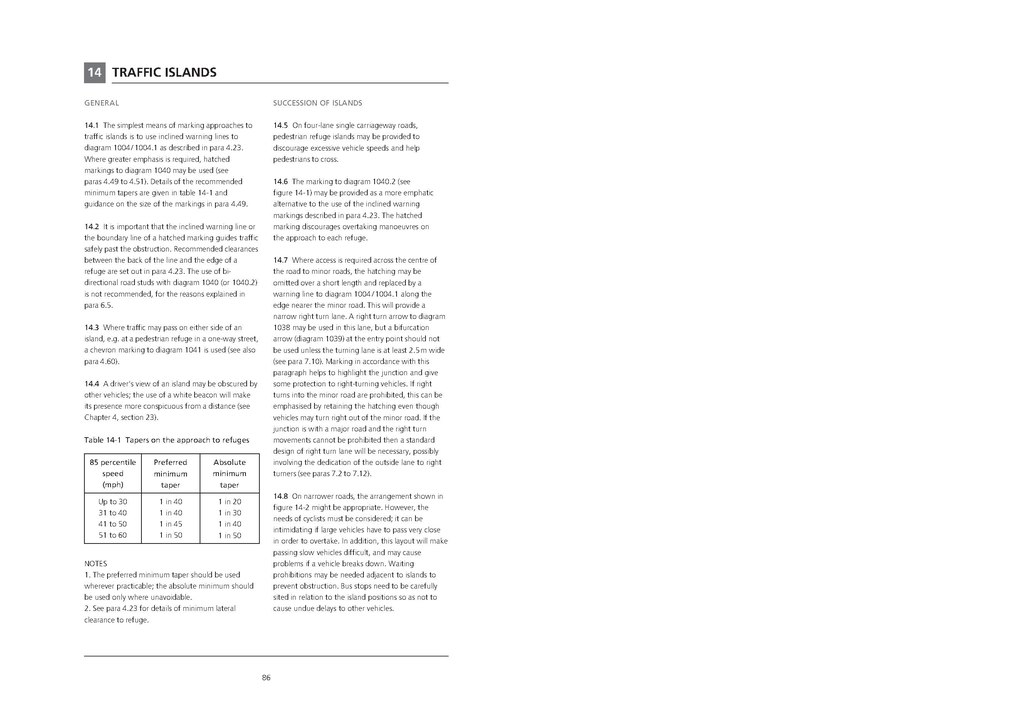14TRAFFIC ISLANDS
GENERAL
14.1 The simplest means of marking approaches to traffic islands is to use inclined warning lines to diagram 1004 / 1004.1 as described in para 4.23. Where greater emphasis is required, hatched markings to diagram 1040 may be used (see paras 4.49 to 4.51). Details of the recommended minimum tapers are given in table 14-1 and guidance on the size of the markings in para 4.49.
14.2 It is important that the inclined warning line or the boundary line of a hatched marking guides traffic safely past the obstruction. Recommended clearances between the back of the line and the edge of a refuge are set out in para 4.23. The use of bidirectional road studs with diagram 1040 (or 1040.2) is not recommended, for the reasons explained in para 6.5.
14.3 Where traffic may pass on either side of an island, e.g. at a pedestrian refuge in a one-way street, a chevron marking to diagram 1041 is used (see also para 4.60).
14.4 A driver's view of an island may be obscured by other vehicles; the use of a white beacon will make its presence more conspicuous from a distance (see Chapter 4, section 23).
| 85 percentile speed (mph) |
Preferred minimum taper |
Absolute minimum taper |
|---|---|---|
| Up to 30 | 1 in 40 | 1 in 20 |
| 31 to 40 | 1 in 40 | 1 in 30 |
| 41 to 50 | 1 in 45 | 1 in 40 |
| 51 to 60 | 1 in 50 | 1 in 50 |
NOTES
- The preferred minimum taper should be used wherever practicable; the absolute minimum should be used only where unavoidable.
- See para 4.23 for details of minimum lateral clearance to refuge.
SUCCESSION OF ISLANDS
14.5 On four-lane single carriageway roads, pedestrian refuge islands may be provided to discourage excessive vehicle speeds and help pedestrians to cross.
14.6 The marking to diagram 1040.2 (see figure 14-1) may be provided as a more emphatic alternative to the use of the inclined warning markings described in para 4.23. The hatched marking discourages overtaking manoeuvres on the approach to each refuge.
14.7 Where access is required across the centre of the road to minor roads, the hatching may be omitted over a short length and replaced by a warning line to diagram 1004 / 1004.1 along the edge nearer the minor road. This will provide a narrow right turn lane. A right turn arrow to diagram 1038 may be used in this lane, but a bifurcation arrow (diagram 1039) at the entry point should not be used unless the turning lane is at least 2.5 m wide (see para 7.10). Marking in accordance with this paragraph helps to highlight the junction and give some protection to right-turning vehicles. If right turns into the minor road are prohibited, this can be emphasised by retaining the hatching even though vehicles may turn right out of the minor road. If the junction is with a major road and the right turn movements cannot be prohibited then a standard design of right turn lane will be necessary, possibly involving the dedication of the outside lane to right turners (see paras 7.2 to 7.12).
14.8 On narrower roads, the arrangement shown in figure 14-2 might be appropriate. However, the needs of cyclists must be considered; it can be intimidating if large vehicles have to pass very close in order to overtake. In addition, this layout will make passing slow vehicles difficult, and may cause problems if a vehicle breaks down. Waiting prohibitions may be needed adjacent to islands to prevent obstruction. Bus stops need to be carefully sited in relation to the island positions so as not to cause undue delays to other vehicles.
86
